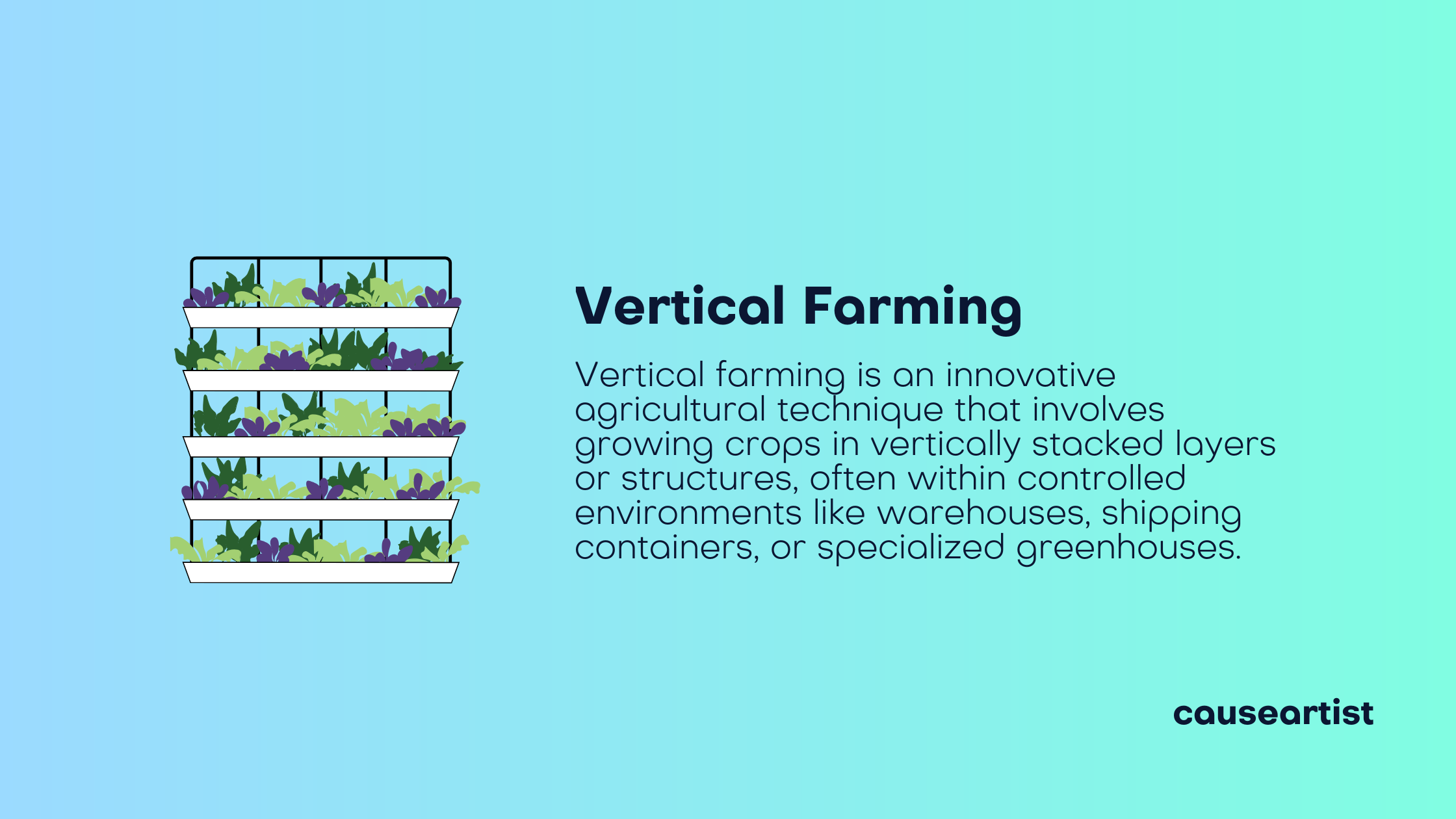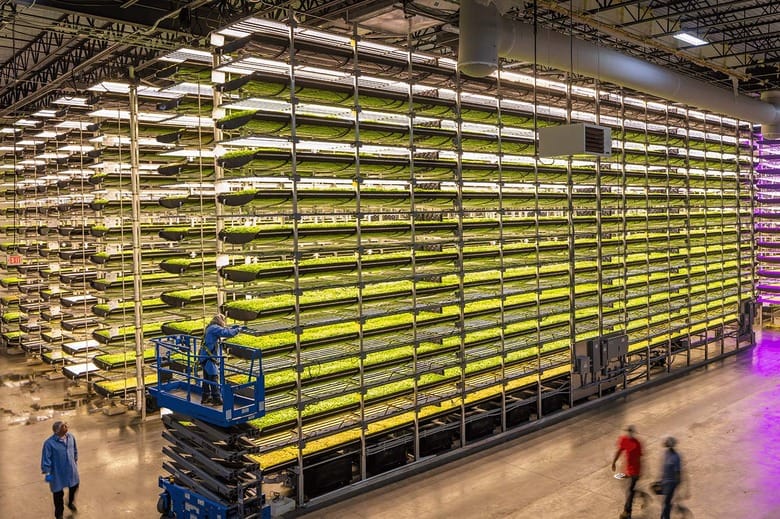Vertical farming has emerged as a revolutionary approach to agriculture, addressing the growing need for sustainable and efficient food production in the face of urbanization, climate change, and resource scarcity.
This guide will explore many facets of vertical farming, examining its advantages and disadvantages, the funding landscape, the future of the industry, and real-world examples of successful vertical farming projects.
What is Vertical Farming?
Vertical farming is an agricultural technique that involves growing crops in vertically stacked layers or structures, often within controlled environments like warehouses, shipping containers, or specialized greenhouses.
By using advanced technologies such as hydroponics (soilless water-based farming), aeroponics (nutrient misting), and artificial lighting, vertical farming optimizes space, water, and energy to produce fresh, high-quality crops year-round.
Unlike traditional horizontal farming, which relies on expansive tracts of arable land, vertical farming maximizes productivity in compact urban spaces.
This makes it especially valuable in cities where land is scarce, and populations are dense. Vertical farming can be implemented in a variety of settings, from abandoned buildings to purpose-built facilities, offering flexible and scalable solutions to meet local food demands.

Advantages of Vertical Farming
Vertical farming offers a compelling alternative to traditional agriculture with numerous benefits:
Environmental Impact:
- Reduced Water Consumption: Vertical farming systems, often employing hydroponics or aeroponics, utilize significantly less water than traditional irrigation methods, with some systems using up to 98% less water.
- Minimized Land Usage: Vertical farms require a fraction of the land used in traditional agriculture, making them ideal for urban environments and areas with limited arable land. This is particularly important considering that agricultural land per person is expected to drop by 66% in 2050 compared to 1970 levels.
- New Geographies: Vertical farming offers the potential to revolutionize food production in arid or challenging environments where traditional agriculture is not feasible.
- Reduced Reliance on Pesticides: The controlled environment of vertical farms minimizes pest infestations, reducing the need for harmful pesticides and herbicides.
- Reduced Reliance on Fossil Fuels: Some vertical farms are incorporating renewable energy sources, such as solar power, to reduce their reliance on fossil fuels and further minimize their environmental impact.
Food Quality and Safety:
- Enhanced Food Safety: Vertical farming practices promote a cleaner and more controlled growing environment, reducing the risk of contamination and ensuring safer food production. Additionally, the reduced reliance on pesticides contributes to the production of healthier and safer food. This controlled environment also helps to minimize food waste, as crops are less susceptible to damage or spoilage.
- Improved Crop Quality: Vertical farms can optimize growing conditions to enhance the flavor, nutritional value, and overall quality of crops.
Productivity and Efficiency:
- Increased Crop Yield: Vertical farms optimize space utilization by growing crops in vertically stacked layers, leading to significantly higher yields per unit area compared to conventional farming. Some vertical farms can produce crop yields up to 240 times that of traditional farms. Furthermore, the controlled environment and reduced crop loss associated with vertical farming help to lower operating expenses and increase farm profits.
- Year-Round Crop Production: By cultivating crops in controlled indoor environments, vertical farms can maintain optimal growing conditions regardless of external weather patterns or seasonal changes, ensuring year-round production.
- Reduced Transportation Costs: By locating vertical farms closer to urban centers, transportation distances are minimized, reducing fuel consumption and associated costs.
Disadvantages of Vertical Farming
Despite its numerous advantages, vertical farming also faces certain challenges:
- High Initial Investment Costs: Setting up a vertical farm requires significant capital investment in specialized equipment, technology, and infrastructure.
- Energy Dependence: Vertical farms rely on artificial lighting and climate control systems, which can result in high energy consumption and operating costs.
- Technical Expertise: Operating a vertical farm requires specialized knowledge and skills in areas such as hydroponics, aeroponics, and environmental control. To address this knowledge gap, initiatives like the USDA's Grand Challenge synergy project on controlled environment agriculture (CEA) are focusing on research and development in this field.
- Limited Crop Diversity: Currently, vertical farming is most suitable for specific crops like leafy greens, herbs, and certain fruits, with limitations on growing taller crops or those requiring extensive root systems.
- Potential for Disease Outbreaks: While controlled environments minimize pest infestations, vertical farms can be susceptible to rapid spread of water-borne diseases if not carefully managed.

Funding in the Vertical Farming Sector
The vertical farming sector has attracted significant investment in recent years, driven by the increasing demand for sustainable food solutions and technological advancements.
This interest is further fueled by the growing consumer demand for locally sourced and sustainable food, presenting opportunities for investors to capitalize on this trend.
| Funding Trend | Description |
|---|---|
| Traditional Financing | Bank loans and grants provide stability and funding for initial setup costs. |
| Government Subsidies and Grants | Governments worldwide are increasingly supporting vertical farming initiatives through subsidies, grants, and incentives to promote sustainable agriculture and urban food production. |
| Venture Capital Investment | Venture capital firms are actively investing in vertical farming startups, recognizing the potential for high growth and returns. For example, Plenty formed a joint venture with Abu Dhabi-based Mawarid to build a network of indoor farms in the Middle East. |
| Crowdfunding | Crowdfunding platforms enable vertical farming projects to raise capital from individuals and communities interested in supporting local and sustainable food initiatives. |
| Impact Investing | Impact investors are drawn to vertical farming due to its potential to address social and environmental challenges, such as food security, resource conservation, and climate change mitigation. |
In 2022, the vertical farming industry raised nearly USD 1.4 billion in the first five months, compared to USD 2 billion throughout 2021.
However, it's important to note that this figure is significantly influenced by Plenty's USD 400 million fundraising round in January, representing half of the total amount invested since the beginning of the year.
The USDA has also announced significant investments in urban agriculture, including USD 43.1 million for grants and cooperative agreements.
Future of the Vertical Farming Industry
The future of vertical farming appears promising, with continued innovation and investment driving its growth and development.
Key trends shaping the future of the industry include:
- Technological Advancements: Ongoing research and development in areas like AI, robotics, and sensor technology are expected to further optimize vertical farming systems, improving efficiency, productivity, and crop quality.
- Increased Sustainability: Vertical farming is poised to play a crucial role in creating more sustainable food systems by minimizing resource consumption, reducing environmental impact, and promoting local food production.
- Urban Integration: As urbanization continues, vertical farms are likely to become increasingly integrated into urban landscapes, providing fresh, locally grown produce to urban populations and contributing to urban food security. This is particularly crucial considering the projected 70% increase in global food demand by 2050 and the decreasing availability of farmland.
- Expansion of Crop Diversity: Research is underway to expand the range of crops suitable for vertical farming, including fruits, vegetables, and grains, further enhancing its potential to address global food needs.
- Economic Viability: As technology improves and economies of scale are achieved, vertical farming is expected to become increasingly cost-effective, making it a more viable and competitive alternative to traditional agriculture.
Despite challenges, vertical farming is expected to capture a significant share of the leafy green market and expand into other crop categories in the coming years.

Examples of Vertical Farming Projects
| Project | Size | Crops Grown | Technology Used |
|---|---|---|---|
| Nuvege (Kyoto, Japan) | 30,000 square-foot facility with 57,000 square feet of vertical growing space | Variety of lettuces | Hydroponics, LED lighting systems |
| PlantLab (Den Bosch, Holland) | 54,000 square feet | Tomatoes, cucumbers, lettuce, herbs | Hydroponics, LED technology, climate control system |
| Sky Greens (Singapore) | 3.65 hectares (approximately the size of five football fields) | Chinese cabbage, bak choy, leafy greens, cherry tomatoes, cucumbers, strawberries | A-Go-Gro (AGG) system, translucent greenhouses, aluminum A-frames with growing troughs, hydraulic water-driven system |
| Green Spirit Farms (New Buffalo, Michigan, USA) | No information available | Lettuce, basil, spinach, kale, arugula, peppers, tomatoes, stevia, strawberries, Brussels sprouts | Volksgarden Rotary Garden Unit (RVGS), Vertical Growing Station (VGS) |
| FarmedHere (Bedford Park, Illinois, USA) | Two-story windowless warehouse | Leafy greens, mushrooms, bread, kombucha tea | Aquaponics, aeroponics, fluorescent lighting |
Conclusion
Vertical farming presents a compelling solution to the challenges of modern agriculture, offering a sustainable and efficient approach to food production.
While the industry faces challenges related to initial investment costs and energy consumption, ongoing technological advancements and increasing investment are driving its growth and development.
With its potential to address food security, resource scarcity, and climate change, vertical farming is poised to play a crucial role in shaping the future of agriculture.
However, the vertical farming industry is still in its early stages, and its long-term success will depend on overcoming several key challenges.
These include:
- Competition: The vertical farming landscape is becoming increasingly competitive, with both established players and new entrants vying for market share. Startups will need to differentiate themselves through technological innovation, cost-effectiveness, and strategic partnerships to thrive in this evolving market.
- Scalability and Cost: While technological advancements are improving efficiency, achieving economies of scale and reducing production costs remain crucial for the widespread adoption of vertical farming.
- Consumer Acceptance: Building consumer trust and acceptance of vertical farming produce is essential for market growth. Educating consumers about the benefits of vertical farming, including its sustainability and food safety aspects, will be key to driving demand.
- Regulatory Landscape: Navigating the evolving regulatory landscape surrounding vertical farming, including food safety regulations and building codes, will be crucial for industry growth and standardization.
Despite these challenges, the future of vertical farming holds immense promise.
As technology continues to advance and consumer demand for sustainable food solutions grows, vertical farming is well-positioned to revolutionize agriculture and contribute to a more secure and sustainable food future.








